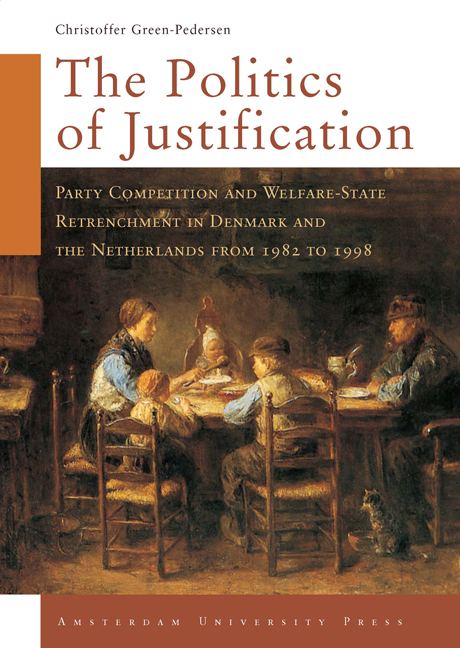 The Politics of Justification
The Politics of Justification Published online by Cambridge University Press: 15 January 2021
The aim of this chapter is to take a closer look at Dutch politics and welfarestate retrenchment from 1982 to 1998. Yet, to make sense of what has happened from 1982, it is necessary to start out with a short section on Dutch politics and welfare-state retrenchment in the preceding period, 1973 to 1982. Subsequently, there will be sections describing each of the three types of governments that ruled the Netherlands in this period; the CDA-VVD governments from 1982 to 1989, the CDA-PVDA government from 1989 to 1994, and the PVDA-VVD-d66 governments from 1994.
More specifically, the aim is to establish how party strategies around retrenchment developed in the period in relation to other political parties and in relation to the electorate. For each period, there will be an investigation into the government initiatives concerning the welfare state, the societal reactions, how the governments have tried to legitimise their policies, and the reaction of the opposition. The focus will be on social security. Nevertheless, developments in other policy areas will be included to the extent that they are necessary to make sense of what happened in relation to social security. These issues have been studied using both primary and secondary sources.
Depillarisation and fumbling response to the oil crises
From a historical perspective, Dutch politics are one of the clearest examples of the politics of accommodation inherent in Lijphart's (1969) concept of ‘consociational democracy’. Due to a consensus at the elite level about power sharing, autonomy for the sub-cultures and proportionality, the conflicts stemming from the ‘pillarisation’ of Dutch society never materialised into an adversarial style of politics that could have threatened democratic stability (Lijphart 1979; Gladdish 1991: 33-49; Andeweg & Irwin 1993: 23-49). The consensual style of politics was also clearly visible in relation to party competition. In the two decades following the Second World War, the Netherlands was mainly governed by oversized coalitions. Members of these governments belonged to one or more of the three major denominational parties, KVP, CHU, or ARP, and either the Social Democrats (PVDA) or the Liberals (VVD) (Andeweg & Irwin 1993: 119).
To save this book to your Kindle, first ensure [email protected] is added to your Approved Personal Document E-mail List under your Personal Document Settings on the Manage Your Content and Devices page of your Amazon account. Then enter the ‘name’ part of your Kindle email address below. Find out more about saving to your Kindle.
Note you can select to save to either the @free.kindle.com or @kindle.com variations. ‘@free.kindle.com’ emails are free but can only be saved to your device when it is connected to wi-fi. ‘@kindle.com’ emails can be delivered even when you are not connected to wi-fi, but note that service fees apply.
Find out more about the Kindle Personal Document Service.
To save content items to your account, please confirm that you agree to abide by our usage policies. If this is the first time you use this feature, you will be asked to authorise Cambridge Core to connect with your account. Find out more about saving content to Dropbox.
To save content items to your account, please confirm that you agree to abide by our usage policies. If this is the first time you use this feature, you will be asked to authorise Cambridge Core to connect with your account. Find out more about saving content to Google Drive.